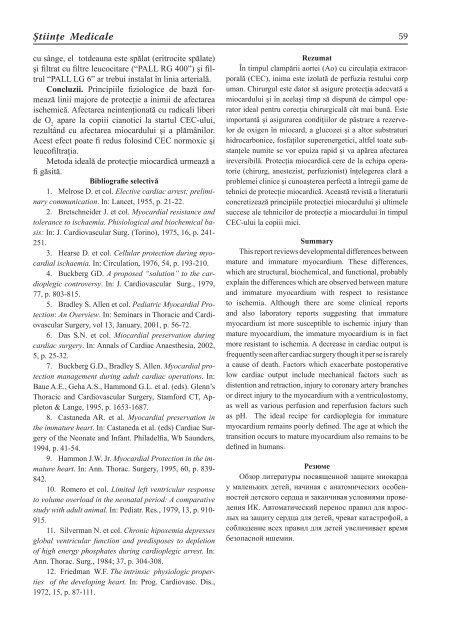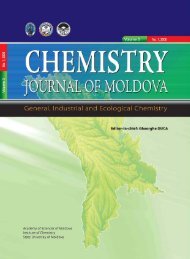stiinte med 3 2011.indd - Academia de ÅtiinÅ£e a Moldovei
stiinte med 3 2011.indd - Academia de ÅtiinÅ£e a Moldovei
stiinte med 3 2011.indd - Academia de ÅtiinÅ£e a Moldovei
You also want an ePaper? Increase the reach of your titles
YUMPU automatically turns print PDFs into web optimized ePapers that Google loves.
Ştiinţe Medicale<br />
cu sânge, el tot<strong>de</strong>auna este spălat (eritrocite spălate)<br />
şi filtrat cu filtre leucocitare (“PALL RG 400”) şi filtrul<br />
“PALL LG 6” ar trebui instalat în linia arterială.<br />
Concluzii. Principiile fiziologice <strong>de</strong> bază formează<br />
linii majore <strong>de</strong> protecţie a inimii <strong>de</strong> afectarea<br />
ischemică. Afectarea neintenţionată cu radicali liberi<br />
<strong>de</strong> O 2<br />
apare la copiii cianotici la startul CEC-ului,<br />
rezultând cu afectarea miocardului şi a plămânilor.<br />
Acest efect poate fi redus folosind CEC normoxic şi<br />
leucofiltraţia.<br />
Metoda i<strong>de</strong>ală <strong>de</strong> protecţie miocardică urmează a<br />
fi găsită.<br />
Bibliografie selectivă<br />
1. Melrose D. et col. Elective cardiac arrest; preliminary<br />
communication. In: Lancet, 1955, p. 21-22.<br />
2. Bretschnei<strong>de</strong>r J. et col. Myocardial resistance and<br />
tolerance to ischaemia. Phisiological and biochemical basis:<br />
In: J. Cardiovascular Surg. (Torino), 1975, 16, p. 241-<br />
251.<br />
3. Hearse D. et col. Cellular protection during myocardial<br />
ischaemia. In: Circulation, 1976, 54, p. 193-210.<br />
4. Buckberg GD. A proposed “solution” to the cardioplegic<br />
controversy. In: J. Cardiovascular Surg., 1979,<br />
77, p. 803-815.<br />
5. Bradley S. Allen et col. Pediatric Myocardial Protection:<br />
An Overview. In: Seminars in Thoracic and Cardiovascular<br />
Surgery, vol 13, January, 2001, p. 56-72.<br />
6. Das S.N. et col. Miocardial preservation during<br />
cardiac surgery. In: Annals of Cardiac Anaesthesia, 2002,<br />
5, p. 25-32.<br />
7. Buckberg G.D., Bradley S. Allen. Myocardial protection<br />
management during adult cardiac operations. In:<br />
Baue A.E., Geha A.S., Hammond G.L. et al. (eds). Glenn’s<br />
Thoracic and Cardiovascular Surgery, Stamford CT, Appleton<br />
& Lange, 1995, p. 1653-1687.<br />
8. Castaneda AR. et al. Myocardial preservation in<br />
the immature heart. In: Castaneda et al. (eds) Cardiac Surgery<br />
of the Neonate and Infant. Phila<strong>de</strong>lfia, Wb Saun<strong>de</strong>rs,<br />
1994, p. 41-54.<br />
9. Hammon J.W. Jr. Myocardial Protection in the immature<br />
heart. In: Ann. Thorac. Surgery, 1995, 60, p. 839-<br />
842.<br />
10. Romero et col. Limited left ventricular response<br />
to volume overload in the neonatal period: A comparative<br />
study with adult animal. In: Pediatr. Res., 1979, 13, p. 910-<br />
915.<br />
11. Silverman N. et col. Chronic hipoxemia <strong>de</strong>presses<br />
global ventricular function and predisposes to <strong>de</strong>pletion<br />
of high energy phosphates during cardioplegic arrest. In:<br />
Ann. Thorac. Surg., 1984; 37, p. 304-308.<br />
12. Friedman W.F. The intrinsic physiologic properties<br />
of the <strong>de</strong>veloping heart. In: Prog. Cardiovasc. Dis.,<br />
1972, 15, p. 87-111.<br />
59<br />
Rezumat<br />
În timpul clampării aortei (Ao) cu circulaţia extracorporală<br />
(CEC), inima este izolată <strong>de</strong> perfuzia restului corp<br />
uman. Chirurgul este dator să asigure protecţia a<strong>de</strong>cvată a<br />
miocardului şi în acelaşi timp să dispună <strong>de</strong> câmpul operator<br />
i<strong>de</strong>al pentru corecţia chirurgicală cât mai bună. Este<br />
importantă şi asigurarea condiţiilor <strong>de</strong> păstrare a rezervelor<br />
<strong>de</strong> oxigen în miocard, a glucozei şi a altor substraturi<br />
hidrocarbonice, fosfaţilor superenergetici, altfel toate substanţele<br />
numite se vor epuiza rapid şi va apărea afectarea<br />
ireversibilă. Protecţia miocardică cere <strong>de</strong> la echipa operatorie<br />
(chirurg, anestezist, perfuzionist) înţelegerea clară a<br />
problemei clinice şi cunoaşterea perfectă a întregii game <strong>de</strong><br />
tehnici <strong>de</strong> protecţie miocardică. Această revistă a literaturii<br />
concretizează principiile protecţiei miocardului şi ultimele<br />
succese ale tehnicilor <strong>de</strong> protecţie a miocardului în timpul<br />
CEC-ului la copiii mici.<br />
Summary<br />
This report reviews <strong>de</strong>velopmental differences between<br />
mature and immature myocardium. These differences,<br />
which are structural, biochemical, and functional, probably<br />
explain the differences which are observed between mature<br />
and immature myocardium with respect to resistance<br />
to ischemia. Although there are some clinical reports<br />
and also laboratory reports suggesting that immature<br />
myocardium ist more susceptible to ischemic injury than<br />
mature myocardium, the immature myocardium is in fact<br />
more resistant to ischemia. A <strong>de</strong>crease in cardiac output is<br />
frequently seen after cardiac surgery though it per se is rarely<br />
a cause of <strong>de</strong>ath. Factors which exacerbate postoperative<br />
low cardiac output inclu<strong>de</strong> mechanical factors such as<br />
distention and retraction, injury to coronary artery branches<br />
or direct injury to the myocardium with a ventriculostomy,<br />
as well as various perfusion and reperfusion factors such<br />
as pH. The i<strong>de</strong>al recipe for cardioplegia for immature<br />
myocardium remains poorly <strong>de</strong>fined. The age at which the<br />
transition occurs to mature myocardium also remains to be<br />
<strong>de</strong>fined in humans.<br />
Резюме<br />
Обзор литературы посвященной защите миокарда<br />
у маленьких детей, начиная с анатомических особенностей<br />
детского сердца и заканчивая условиями проведения<br />
ИК. Автоматический перенос правил для взрослых<br />
на защиту сердца для детей, чреват катастрофой, а<br />
соблюдение всех правил для детей увеличивает время<br />
безопасной ишемии.

















